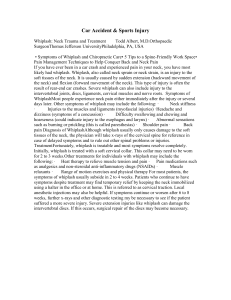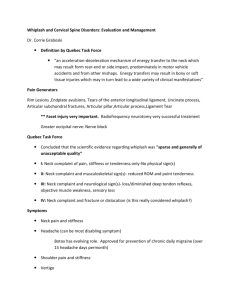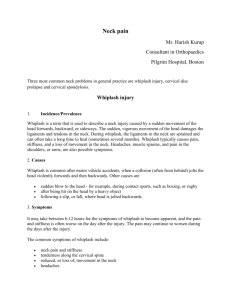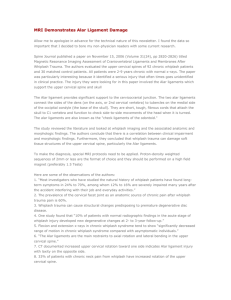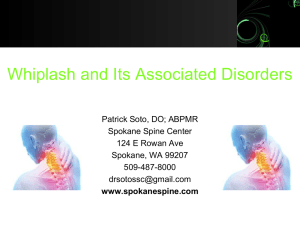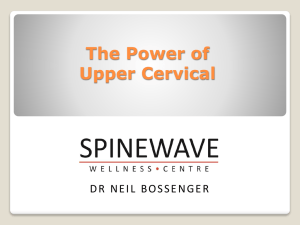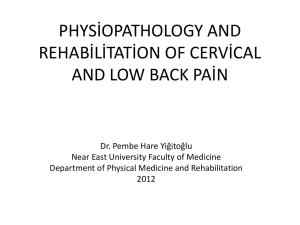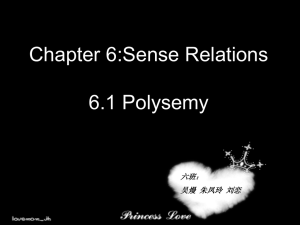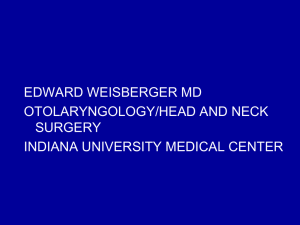Event dated June 2014
advertisement
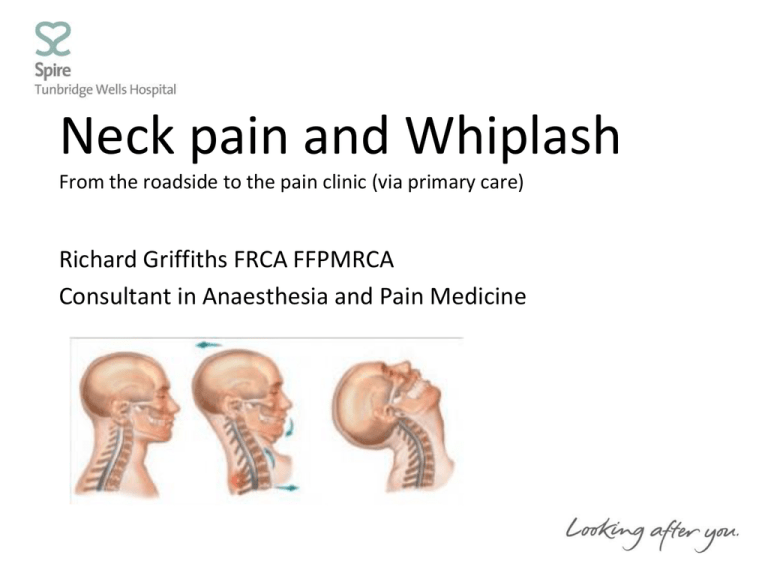
Neck pain and Whiplash From the roadside to the pain clinic (via primary care) Richard Griffiths FRCA FFPMRCA Consultant in Anaesthesia and Pain Medicine Agenda • • • • • Resources Definitions Case histories Evidence Guidance • Questions on the way… Neck pain, whiplash and WAD NICE Clinical knowledge summaries 2013 Neck pain Clinical Evidence 2007 Whiplash injury B J Bone and Joint 2008 Whiplash associated disorders Parts 1&2 Pain Research and Management 2010 The diagnosis and treatment of nonspecific neck pain and whiplash Euramedicophys 2007 Percuteneous radiofrequency neurotomy NEJM 1996 Cochrane Summaries Dr Wikipedia Carotid artery dissection Acute coronary syndrome Head and neck cancer Retropharyngeal abscess Epiglottitis Cervical disc herniation Cervical stenosis Spondylosis Stress Referred pain Overuse Muscular pain Whiplash Neck pain • Pain in the cervical area • Referred into occiput, shoulders and upper limbs • Stiffness predominates “2/3 of the population will experience neck pain. 10% becomes chronic” Cervical spondylosis 9/10 of patients above 65 years have this Medicalising “normal” Radiographic changes correlate poorly to symptoms ######## ######## Brachialgia Cervical radiculopathy Pain in upper limb from entrapment of cervical nerve root(s) ##### ####### ##### ###### 28 year old female RTA 18 months – rear impact, ongoing litigation Neck pain Low back pain, fatigue and headaches Unhelpful physical therapy No red flags Trauma Systemic symptoms Progressive pain Night pain Motor signs Prior spinal disease (surgery, osteoporosis) Age extremes Differential diagnosis • • • • • • • • Soft tissue injury Mechanical lesions – eg. disc injury Inflammatory - arthropathies Metabolic – Paget’s, osteoporosis Infective – including TB Malignancy - 1°, 2° and myeloma Fibromyalgia Whiplash ########### ######### Whiplash and WAD “an acceleration-deceleration mechanism of energy transfer in the neck” WAD – Whiplash associated disorder Neck pain (>88%) Headache Spinal pain Fatigue, dizziness, parasthesia Anxiety and depression Whiplash “an acceleration-deceleration mechanism of energy transfer in the neck” Question 1 • Whiplash accounts for what proportion of motor insurance claims? • 35% • 58% • 76% Pathophysiology • Source of pain unclear Cervical facet joints Anterior longitudinal ligament Trapezius muscle Supraspinatus muscle Brain injury (contra-coup) • Peripheral and central spinal cord sensitisation Whiplash - classification “an acceleration-deceleration mechanism of energy transfer in the neck” Quebec Taskforce grading Acute whiplash 0 - 12 weeks Chronic whiplash > 12 weeks I No neck complaint II Pain/stiffness osigns III Pain + ROM + Tenderness IV as above with neuro signs V as above with fracture/ dislocation Question 2 Which of the following would now be described as whiplash? • Railway spine • Spinal concussion • Cervical sprain Radiology and whiplash When should I image the neck? Not routinely Any red flags Concerned re. serious pathology (radiculopathy / myelopathy) To reassure? To reinforce illness behaviour? Cervical MRI Consider nerve conduction studies Prognosis Great variation Factors that lead to poor prognosis are: high initial disability high initial pain scores low self efficacy catastrophising educational level 1 month 12 months 2 years 5 years %recovered 44% 65% 75% VAS (0-10) 3.8 2.5 2.2 - South Australasia Centre for trauma 2008 Question 3 What proportion of headrests are incorrectly positioned? • 20% • 50% • 70% WHO Analgesic ladder Step 1 Step 2 Step 2 3 Step 3 Paracetamol NSAIDS / COX II inhibitors Codeine Dihydrocodeine Co-analgesics Tramadol Tapenthadol Zomorph Oxycontin Acute whiplash – guidance NICE clinical knowledge summaries • • • • • • Diagnosis and exclude sinister causes Reassurance Encourage return to normal activity Discourage rest and immobilisation Simple analgesia Physiotherapy • Treat anxiety and low mood Late whiplash > 3 months • Bio-psychosocial model of pain • Whiplash associated disorder Neck pain (>88%) Headache Spinal pain Fatigue dizziness parathesia • Symptom amplification • Anxiety, PTSD, depression • Litigation The effect of litigation How society views whiplash may determine its clinical presentation and prognosis Greece & Lithuania have little WAD Quebec – 12% not recovered at 1 year Litigation delays recovery Evidence Exercise for chronic neck pain • Active, ultrasound assisted, passive techniques, stabilisation, • Safe • Benign side effects “there appears to be a role for exercises in the treatment of chronic neck pain and cervicogenic headache if stretching and strengthening exercises are focused on the neck and shoulder blade region” Acupuncture for chronic neck pain • 10 trials investigated • 668 patients ACU compared to sham or waiting list “Individuals with chronic neck pain who received acupuncture reported, better pain relief immediately after treatment and in the short-term than those who received sham treatments and waiting list controls”. Traction for chronic neck pain • • • • 7 RCTs investigated 1 had LOW risk of bias 100 patients Intermittent or continuous traction “In summary, our review found no evidence from RCTs with a low potential for bias that clearly supports or refutes the use of either continuous or intermittent traction for individuals with chronic neck disorders”. Pillows “No evidence in a cross over study that “special neck pillows” outperformed a normal pillow” Cochrane Review 2011 Recommendations chronic whiplash NICE clinical knowledge summaries • Encourage return to normal activity • Discourage rest and immobilisation • Simple analgesia • Trial of anti-neuropathic medications “Anti-neuropathics are “reasonable” for chronic neck pain / WAD” McQuay 2011 • Treat anxiety and depression Not recommended • Surgery • Cervical epidurals • Botox injections Cervical rhizotomy may be useful… Cervical intervention Lord, Bogduk et al NEJM 1996 • 24 patients • Proven cervical facet joint pain after whiplash • Multi-level cervical facet rhizotomy (80°C) • Telephone follow up Following whiplash injury, patients with proven chronic cervical facet joint pain can gain lasting relief (9 months) from radiofrequency neurotomy” Common questions What effect do immobilisation collars have? Not good - prolonged use promotes loss of function Do pillows make a difference? Not really – but you’re welcome to try Is physio helpful? Yes – active treatments outperform passive therapy Does age matter? Probably - old age is associated with poor prognosis Could exercise help? Yes – Cochrane recommends stretching and strengthening exercises Summary • Neck pain is common • Whiplash is common (*especially after an RTC) • Reassure, movement and analgesia for all • Image only when worried • Consider pain clinic referral when symptoms persists
